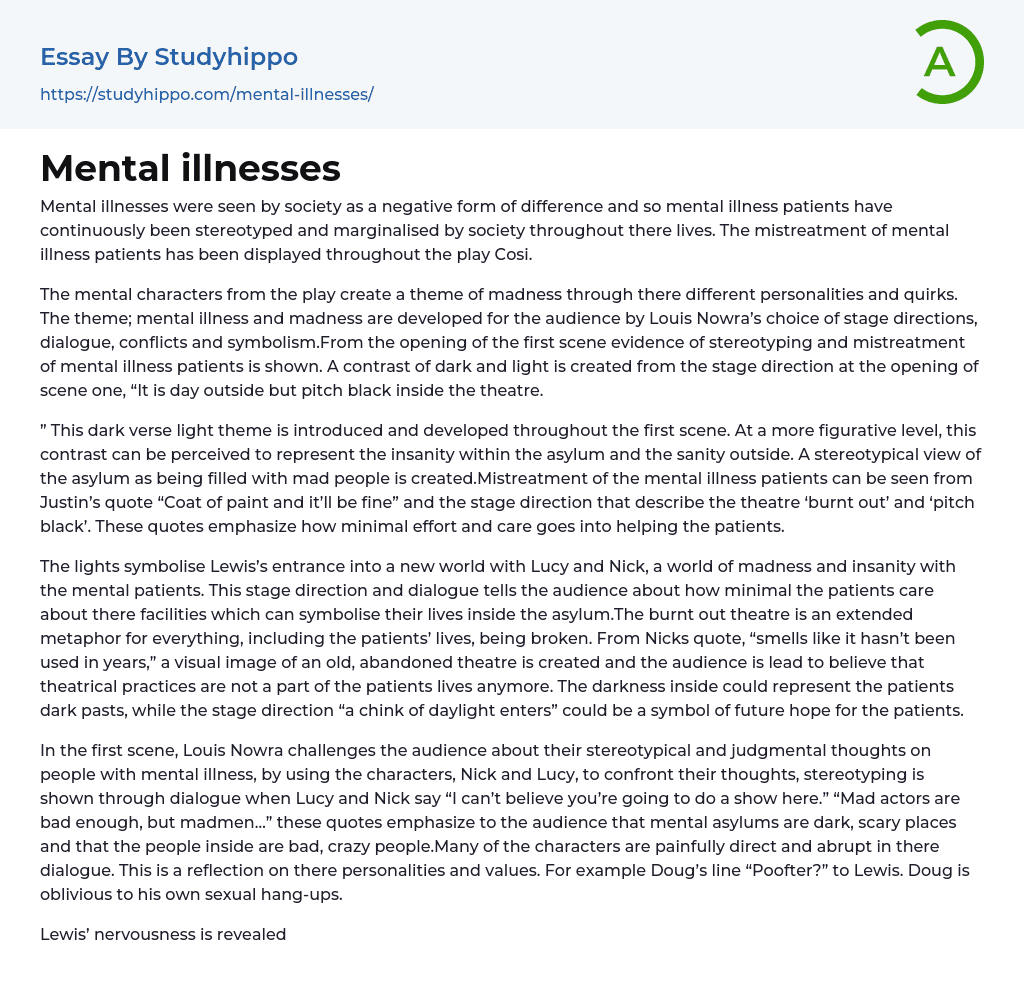Throughout their lives, mental illness patients have been stigmatized and excluded from society due to the negative perception of mental disorders. This mistreatment is evident in the play Cosi.
Louis Nowra employs stage directions, dialogue, conflicts, and symbolism to establish a theme of mental illness and madness through the diverse personalities and quirks of the characters in his play. The mistreatment of patients suffering from mental illnesses is highlighted from the opening scene, which also offers a contrast between darkness and light with the stage direction stating, "It is day outside but pitch black inside the theatre".
The first scene introduces and develops a theme of dark verse light contrast. This contrast can be interpreted figuratively as representing the insanity within the asylum versus the sanity outside. The portrayal of the asylum as being fi
...lled with mad people creates a stereotypical view. Mistreatment of mental illness patients is evidenced by Justin’s quote “Coat of paint and it’ll be fine” and the stage direction describing the theatre as ‘burnt out’ and ‘pitch black’. These quotes highlight the lack of effort and care given to helping patients.
The lights are symbolic of Lewis joining a new world with Lucy and Nick, a world of madness and insanity with mental patients. This stage direction and dialogue demonstrate the patients' minimal concern for their facilities, which serves as a metaphor for their lives inside the asylum. The burnt-out theatre is also an extended metaphor for brokenness in all aspects, including patients' lives. When Nick says, "smells like it hasn't been used in years," the audience gets a visual of an old, abandoned theatre, making it clear that theatrical practice is no
part of the patients' lives anymore. The darkness within could represent their dark pasts, while "a chink of daylight enters" in the stage direction could symbolize hope for their future.
In the opening scene, Louis Nowra challenges the audience's preconceptions and discriminatory attitudes towards individuals with mental illness. The characters of Nick and Lucy are utilized to confront these stereotypes through dialogue such as “I can’t believe you’re going to do a show here.” and “Mad actors are bad enough, but madmen…” which highlight the portrayal of asylums as grim and inhabitants as unstable. In addition, many characters exhibit blunt and direct speech that reflects their personalities and values. For instance, Doug's utterance of "Poofter?" towards Lewis demonstrate his ignorance regarding his own sexual biases.Lewis’ anxiety is evident in his lack of response to Doug, as seen in the opening scene where conflict, chaos, and madness prevail. Roy threatens Doug by saying “Shut up, or I'll knock your block off,” exposing Roy’s mental instability and Doug’s inability to control his temper during disagreements. This representation of mental illness patients as psycho, uncontrollable individuals may lead the audience to believe negative stereotypes. Justin's statement, “You must feel a bit queasy. I know I was when I first came to work in an asylum. The thing is and you’ll discover this, is that they are just normal people, well not quite normal, or else they wouldn’t be in here, would they? But you get my drift?” reflects the transformation in Justin's view of patients and highlights Lewis's discomfort with working in the asylum. By speaking in this manner to Lewis, Justin demonstrates the mistreatment of patients and their
exclusion as ‘different people’ from any ‘normal person’ outside the asylum.
Nowra uses a play within a play structure to portray madness and chaos as symbolic of mental patients. This approach highlights issues and concerns related to mental illness, while also promoting stereotypes, as shown when Justin tells Lewis that the patients are not dangerous. Such stereotypes create the impression that mental patients are crazy murderers.
Louis Nowra's plays Cosi and its sequel maintain a sense of madness and chaos in their structures, particularly towards the characters of Lewis and Nick as they direct the inmates. This creates an unorganized atmosphere that reflects the diverse personalities depicted throughout both plays. Nowra successfully portrays crucial themes and ideas through dialogue, conflict, symbolism, and stage direction. Mental illness and madness are prominent themes that Nowra addresses, utilizing stereotypical views to confront the audience's perspective on the treatment of those suffering from such conditions.
- Insanity essays
- Anthropology essays
- Audience essays
- Charity essays
- Cultural Competence essays
- Emile Durkheim essays
- Gender Roles essays
- Generation essays
- Globalization essays
- Interpersonal Relationship essays
- People essays
- Race essays
- Social Change essays
- Social Class essays
- Social Movement essays
- Social Science essays
- Social Status essays
- Social Stratification essays
- Society essays
- Sociological Imagination essays
- Sociological Perspective essays
- Sociological Theories essays
- Stereotypes essays
- Web Dubois essays




